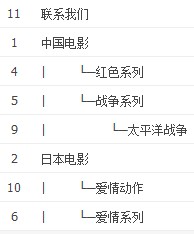分享一个php实现无限级分类程序代码
发布:smiling 来源: PHP粉丝网 添加日期:2014-01-16 13:44:25 浏览: 评论:0
无限级分类是所有程序开发中会碰到的一个问题,下面我来介绍php+mysql实现的一个无限级分类程序,有需要的朋友可参考参考,下面给大家看看我的数据库结构吧,数据库的名字为 fa_category
Field Type Comment
cid int(11) 分类id
catename varchar(255) 分类名字
catetype int(1) 分类类型,1为单页面,2为普通分类
catdir varchar(255) 英文目录
display int(1) 1为显示,2为不显示
keywords varchar(255) 栏目关键字
description text 栏目描述
ctime int(11) 创建时间
parentid int(11) 父节点id,最高节点父节点为0
我们使用一个parentid字段来记录父节点的id,如果parentid为0,则为root,不多说,我们看看代码怎么写吧,我们要实现的功能就是如图片所示:

怎么样把它这样显示呢?这个问题我想了很久,先看看这段SQL语句吧,代码如下:
- SELECT c.cat_id, c.cat_name, c.measure_unit, c.parent_id, c.is_show, c.show_in_nav, c.grade ,c.sort_order, COUNT( s.cat_id ) AS has_children
- FROM ecs_category AS c
- LEFT JOIN ecs_category AS s ON s.parent_id = c.cat_id
- GROUP BY c.cat_id
- ORDER BY c.parent_id, c.sort_order ASC
用左连接连接一个表,返回一个字段 has_children,这个字段是记录有多少子节点,看看代码吧:
- public function getCategory($catid=0,$re_type = true,$selected=0)
- {
- $db = new Public_DataBase();
- $sql = 'select c.cid,c.catename,c.catetype,c.ctime,c.parentid,count(s.cid) as has_children from '.
- __MYSQL_PRE.'category as c left join '.
- __MYSQL_PRE.'category as s on s.parentid=c.cid group by c.cid order by c.parentid asc';
- $res = $db->selectTable($sql);
- $cateInfo = self::getChildTree($catid,$res);
- if($re_type==true)
- {
- $select = '';
- foreach($cateInfo as $val)
- {
- $select .= '<option value="' . $val['cid'] . '" ';
- $select .= ($selected == $val['cid']) ? "selected='ture'" : '';
- $select .= '>';
- if($val['level']>0)
- {
- $select .= str_repeat(' ', $val['level'] * 4);
- }
- $select .= htmlspecialchars(addslashes($val['catename']), ENT_QUOTES) . '</option>';
- }
- return $select;
- }
- else
- {
- foreach($cateInfo as $key=>$val)
- {
- if($val['level']>0)
- {
- $cateInfo[$key]['catename'] = "|".str_repeat(' ', $val['level'] * 8)."└─".$val['catename'];
- }
- }
- return $cateInfo;
- }
- }
- /**
- * 通过父ID递归得到所有子节点树
- * @param int $catid 上级分类
- * @param array $arr 含有所有分类的数组
- * @return array
- */
- public function getChildTree($catid,$arr)
- {
- $level = $last_cat_id = 0;
- while (!emptyempty($arr))
- {
- foreach($arr as $key=>$value)
- {
- $cid = $value['cid'];
- if ($level == 0 && $last_cat_id == 0)
- {
- if ($value['parentid'] > 0)
- {
- break;
- }
- $options[$cid] = $value;
- $options[$cid]['level'] = $level;
- $options[$cid]['id'] = $cid;
- $options[$cid]['name'] = $value['catename'];
- unset($arr[$key]);
- if ($value['has_children'] == 0)
- {
- continue;
- }
- $last_cat_id = $cid;
- $cat_id_array = array($cid);
- $level_array[$last_cat_id] = ++$level;
- continue;
- }
- if ($value['parentid'] == $last_cat_id)
- {
- $options[$cid] = $value;
- $options[$cid]['level'] = $level;
- $options[$cid]['id'] = $cid;
- $options[$cid]['name'] = $value['catename'];
- unset($arr[$key]);
- if ($value['has_children'] > 0)
- {
- if (end($cat_id_array) != $last_cat_id)
- {
- $cat_id_array[] = $last_cat_id;
- }
- $last_cat_id = $cid;
- $cat_id_array[] = $cid;
- $level_array[$last_cat_id] = ++$level;
- }
- }
- elseif ($value['parentid'] > $last_cat_id)
- {
- break;
- }
- }
- $count = count($cat_id_array);
- if ($count > 1)
- {
- $last_cat_id = array_pop($cat_id_array);
- }
- elseif ($count == 1)
- {
- if ($last_cat_id != end($cat_id_array))
- {
- $last_cat_id = end($cat_id_array);
- }
- else
- {
- $level = 0;
- $last_cat_id = 0;
- $cat_id_array = array();
- continue;
- }
- }
- if ($last_cat_id && isset($level_array[$last_cat_id]))
- {
- $level = $level_array[$last_cat_id];
- }
- else
- {
- $level = 0;
- }
- }
- return $options;
- }
用smarty的一个循环就可以把它显示出来,效果和上面图片的一样!大家有什么问题可以给我留言。
Tags: 无限级 分类程序
- 上一篇:php ajax用户登陆验证程序代码
- 下一篇:php生成静态页面程序
相关文章
- ·php中无限级分类程序代码(2013-12-31)
推荐文章
热门文章
最新评论文章
- 写给考虑创业的年轻程序员(10)
- PHP新手上路(一)(7)
- 惹恼程序员的十件事(5)
- PHP邮件发送例子,已测试成功(5)
- 致初学者:PHP比ASP优秀的七个理由(4)
- PHP会被淘汰吗?(4)
- PHP新手上路(四)(4)
- 如何去学习PHP?(2)
- 简单入门级php分页代码(2)
- php中邮箱email 电话等格式的验证(2)
